display MERCEDES-BENZ C-Class COUPE 2017 CL205 Owner's Guide
[x] Cancel search | Manufacturer: MERCEDES-BENZ, Model Year: 2017, Model line: C-Class COUPE, Model: MERCEDES-BENZ C-Class COUPE 2017 CL205Pages: 354, PDF Size: 8.66 MB
Page 36 of 354
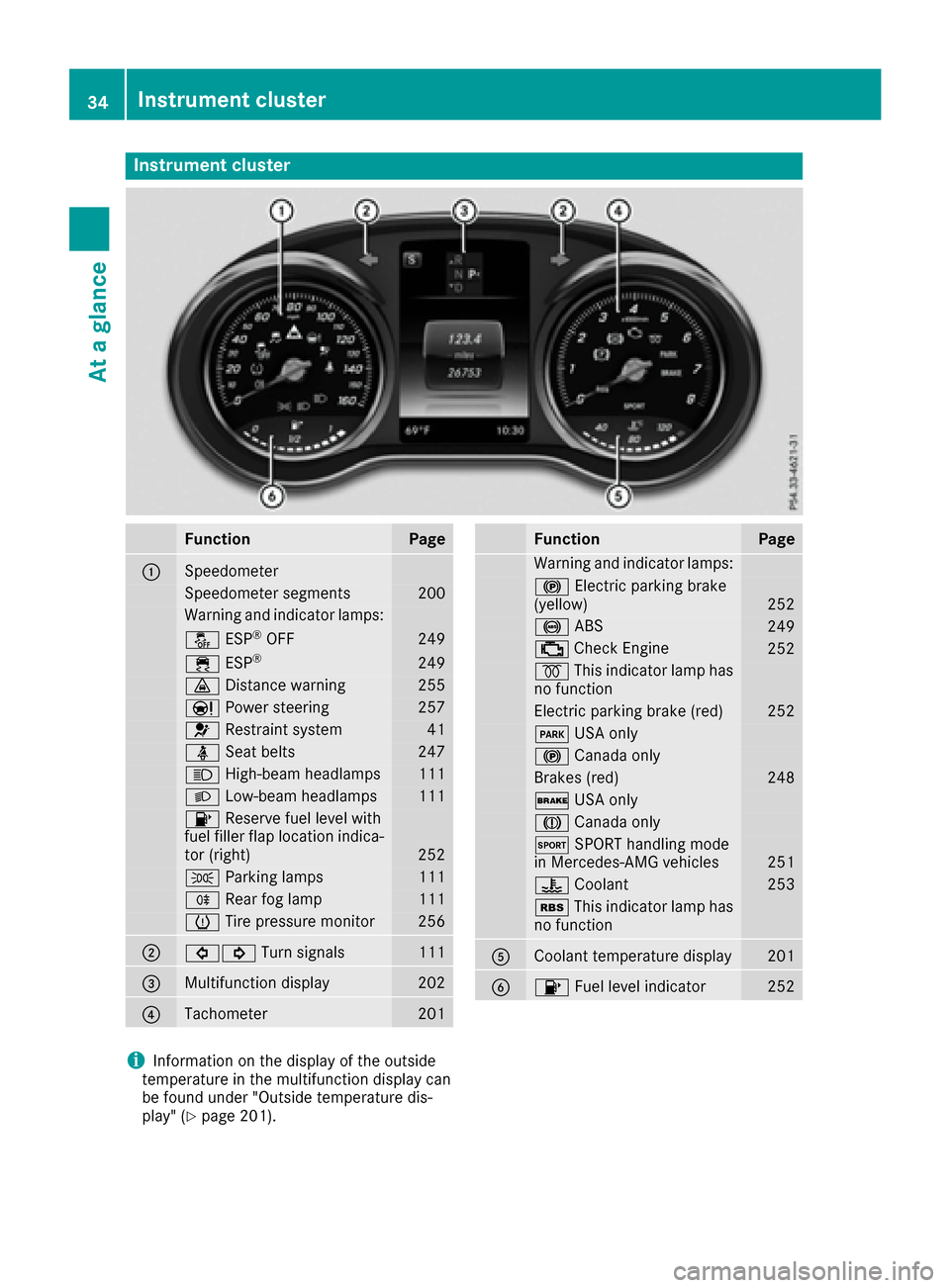
Instrumentcluster
FunctionPag e
:Speedometer
Speedometer segments200
Warning and indicator lamps:
å ESP®OF F249
÷ ESP®24 9
· Distanc ewarning255
Ð Powersteering25 7
6 Restrain tsystem41
ü Seat belt s247
K High-beam headlamps111
L Low-beam headlamps111
8 Reserve fuel level wit h
fuel filler flap location indica-
to r( right )
252
T Parking lamp s111
R Rear fog lamp111
h Tirep ressur emonitor256
;#! Turn signals111
=Multifunction display202
?Tachometer201
FunctionPag e
Warning and indicator lamps:
! Electric parking brak e
(yellow)25 2
! ABS249
; CheckEngine25 2
% This indicator lamp has
no function
Electric parking brak e(red)25 2
F USAo nly
! Canad aonly
Brake s(red)24 8
$ USAo nly
J Canad aonly
M SPORT handlin gmode
in Mercedes-AM Gvehicles251
? Coolan t253
é This indicator lamp has
no function
ACoolan ttem perature display201
B8 Fuellevel indicator25 2
iInformation on th edisplay of th eoutside
temperature in th emultifunction display can
be foun dunder "Outside temperature dis-
play" (
Ypage 201).
34Instrumen tcluster
At ag lance
Page 37 of 354

Multifunction steering wheel
FunctionPage
:Multifunction display202
;Multimediasystem display
=~ Rejects or ends acall
6 Makes or accepts acall
Further telephone functions210
WXAdjusts volume
8 Mute
óSwitchesonv oice-
operated contro lnavigation
or the Voice Control System
FunctionPage
?ò Opens the menu list
9:Selects amenu
a Confirm sthe selection
% Back
Operate sthe on-board com-
puter201
ñ Switches off voice-
operate dcontrol navigation
or the Voice Control System
iIn vehicles with multimedi asystem
COMAND yo ucan find further information:
Ron the multimedi asystem in the Digital
Operator's Manual
Ron the DVD changer or single DVD drive in
the Digital Operator's Manual
Ron the Voice Control System in the sepa-
rate operating instructions
iIn vehicles with multimedi asystem Audio 20
yo uc an find further information:
Ron the multimedi asystem in the Digital
Operator's Manual
Ron the voice-operated control of the navi-
gation in the manufacturer' soperating
instructions
Multifunctions teering wheel35
Atag lance
Page 44 of 354

regular intervalswhile the engine is running.
Therefore, malfunctions can be detected in
good time.
The 6 restraint system warning lamp in the
instrument cluster lights up when the ignitio nis
switched on. It goes out no later than afew sec-
onds after the vehicl eisstarted. The compo-
nents of the restraint system are in operational
readiness.
Am alfunction has occurred if the 6restraint
system warning lamp:
Rdoes not light up after the ignitio nisswitched
on
Rdoes not go out after afew seconds with the
engine running
Rlights up again while the engine is running
GWARNING
If restraint system is malfunctioning, restraint
system components may be triggeredu nin-
tentionall yormight not be triggeredata ll in
the event of an accident with ahigh rate of
vehicl edeceleration. This can affect the Emer-
gency Tensioning Device or air bag ,for exam-
ple. This poses an increase drisk of injury or
even fatal injury.
Have the restraint system checked and
repaired in aqualified specialist workshop as
soon as possible.
PASSENGER AI RBAG indicator lamp
PASSENGER AIR BAG ON indicator lamp :and
PASSENGER AIR BAG OFF indicator lamp ;are
part of the Occupant Classification System
(OCS). The indicator lamp
sdisplay the status of the
front-passenge rfront air bag.
RPASSENGER AIR BAG ON lights up: the front-
passenger front air bag is enabled. If, in the
event of an accident, all deployment criteria
are met, the front-passenge rfront air bag is
deployed.
RPASSENGER AIR BAG OFF lights up: the front-
passenger front air bag is deactivated. It will
then not be deploye dinthe event of an acci-
dent.
Depending on the person in the front-passenger
seat, the front-passenge rfront air bag must
either be deactivated or enabled; see the fol-
lowing points. You must make sure of this both
before and during ajourney.
RChildren in achildr estraint system:
whethe rthe front-passenge rfront air bag is
enabled or deactivated depends on the instal-
led child restraint system, and the age and
size of the child .Therefore, be sure to observe
the notes on the "Occupant Classification
System (OCS)" (
Ypag e49) and on "Chil-
dren in the vehicle" (Ypag e57). There you
wil lalsof ind instructions on rearward and
forward-facing child restraint systems on the
front-passenge rseat.
RAll other persons: depending on the classi-
ficatio nofthe person in the front-passenger
seat, the front-passenge rfront air bag is ena-
bled or deactivated (
Ypag e49). Be sure to
observe the notes on "Seat
belts“ (
Ypag e42) and "Air bags"
(Ypag e46). There you can als ofind infor-
mation on the correct seat position.
Seat belts
Introduction
Seat belts are the most effective means of
restricting the movement of vehicl eoccupants
in the event of an accident or the vehicl erolling
over. This reduces the risk of vehicl eoccupants
coming into contact with parts of the vehicle
interior or being ejected from the vehicle. Fur-
thermore, the seat belt help stokeep the vehicle
occupant in the best position in relation to the
air bag.
42Occupant safety
Safety
Page 52 of 354
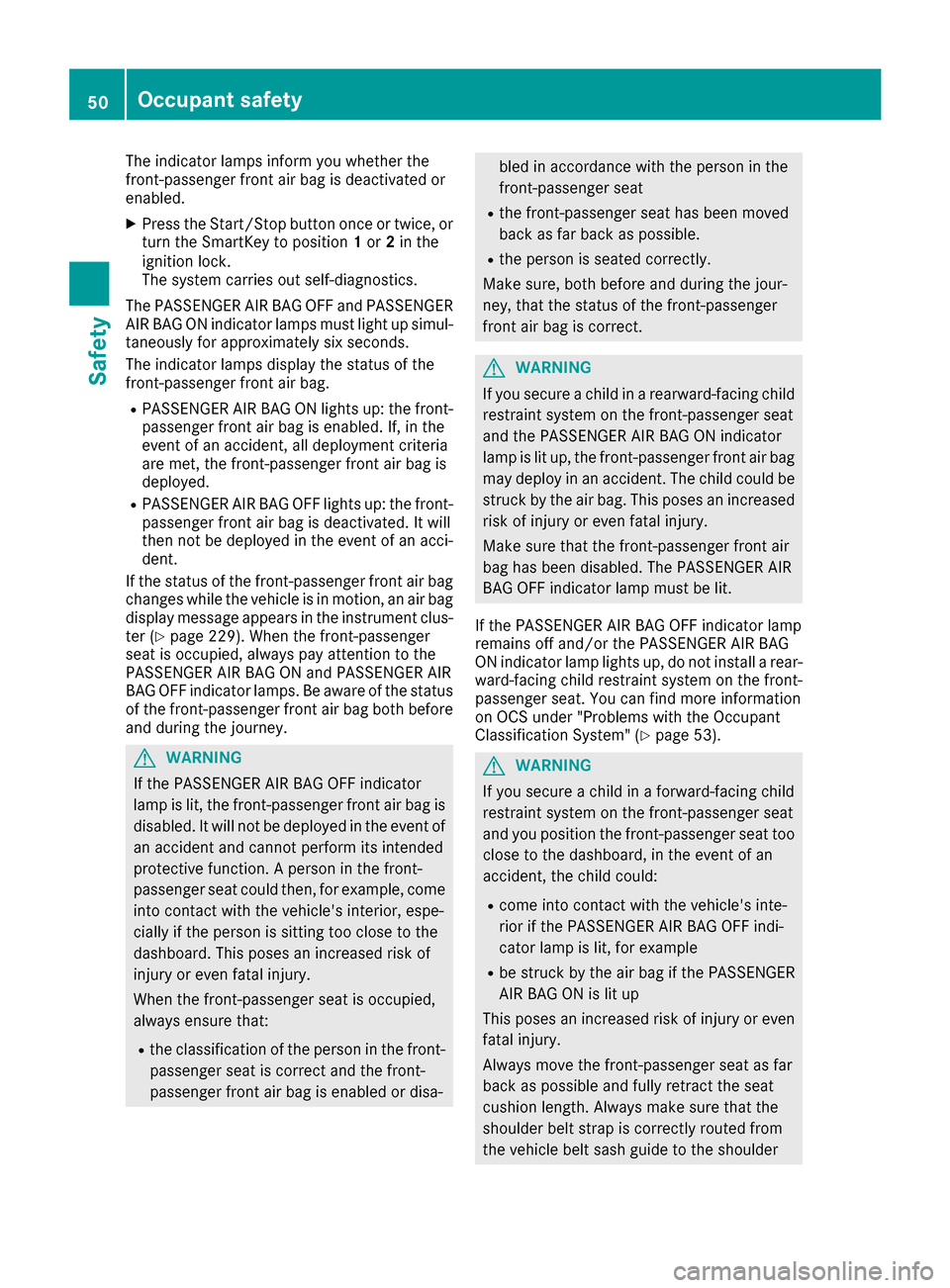
The indicator lamps inform you whether the
front-passenger front air bag is deactivated or
enabled.
XPress the Start/Stop button once or twice, or
turn the SmartKey to position1or 2in the
ignition lock.
The system carries out self-diagnostics.
The PASSENGER AIR BAG OFF and PASSENGER
AIR BAG ON indicator lamps must light up simul-
taneously for approximately six seconds.
The indicator lamps display the status of the
front-passenger front air bag.
RPASSENGER AIR BAG ON lights up: the front-
passenger front air bag is enabled. If, in the
event of an accident ,all deployment criteria
are met, the front-passenger front air bag is
deployed.
RPASSENGER AIR BAG OFF lights up: the front-
passenger front air bag is deactivated. It will
then not be deployed in the event of an acci-
dent.
If the status of the front-passenger front air bag changes while the vehicle is in motion,ana ir bag
display message appears in the instrument clus-
ter (
Ypage 229). When the front-passenger
seat is occupied, alwaysp ay attention to the
PASSENGER AIR BAG ON and PASSENGER AIR
BAG OFF indicator lamps. Be aware of the status
of the front-passenger front air bag both before
and during the journey.
GWARNING
If the PASSENGER AIR BAG OFF indicator
lamp is lit, the front-passenger front air bag is
disabled. It will not be deployed in the event of
an accident and cannot perform its intended
protective function. Aperson in the front-
passenger seat could then ,for example, come
into contact with the vehicle's interior, espe-
cially if the person is sittin gtoo close to the
dashboard. This poses an increased risk of
injury or even fatal injury.
When the front-passenger seat is occupied,
alwayse nsure that:
Rthe classification of the person in the front-
passenger seat is correcta nd the front-
passenger front air bag is enabled or disa-
bled in accordanc ewith the person in the
front-passenger seat
Rthe front-passenger seat has been moved
back as far back as possible.
Rthe person is seated correctly.
Make sure, both before and during the jour-
ney, that the status of the front-passenger
front air bag is correct.
GWARNING
If you secure achild in arearward-facing child
restraint system on the front-passenger seat
and the PASSENGER AIR BAG ON indicator
lamp is lit up, the front-passenger front air bag may deploy in an accident .The child could be
struck by the air bag. This poses an increased
risk of injury or even fatal injury.
Make sure that the front-passenger front air
bag has been disabled. The PASSENGER AIR
BAG OFF indicator lamp must be lit.
If the PASSENGER AIR BAG OFF indicator lamp
remains off and/or the PASSENGER AIR BAG
ON indicator lamp lights up, do not install arear-
ward-facing child restraint system on the front-
passenger seat. You can find more information
on OCS under "Problems with the Occupant
Classification System" (
Ypage 53).
GWARNING
If you secure achild in aforward-facing child
restraint system on the front-passenger seat
and you position the front-passenger seat too close to the dashboard, in the event of an
accident ,the child could:
Rcome into contact with the vehicle's inte-
rior if the PASSENGER AIR BAG OFF indi-
cator lamp is lit, for example
Rbe struck by the air bag if the PASSENGER
AIR BAG ON is lit up
This poses an increased risk of injury or even fatal injury.
Always move the front-passenger seat as far
back as possible and fully retrac tthe seat
cushion length. Always make sure that the
shoulder belt strap is correctly routed from
the vehicle belt sash guide to the shoulder
50Occupant safety
Safety
Page 54 of 354
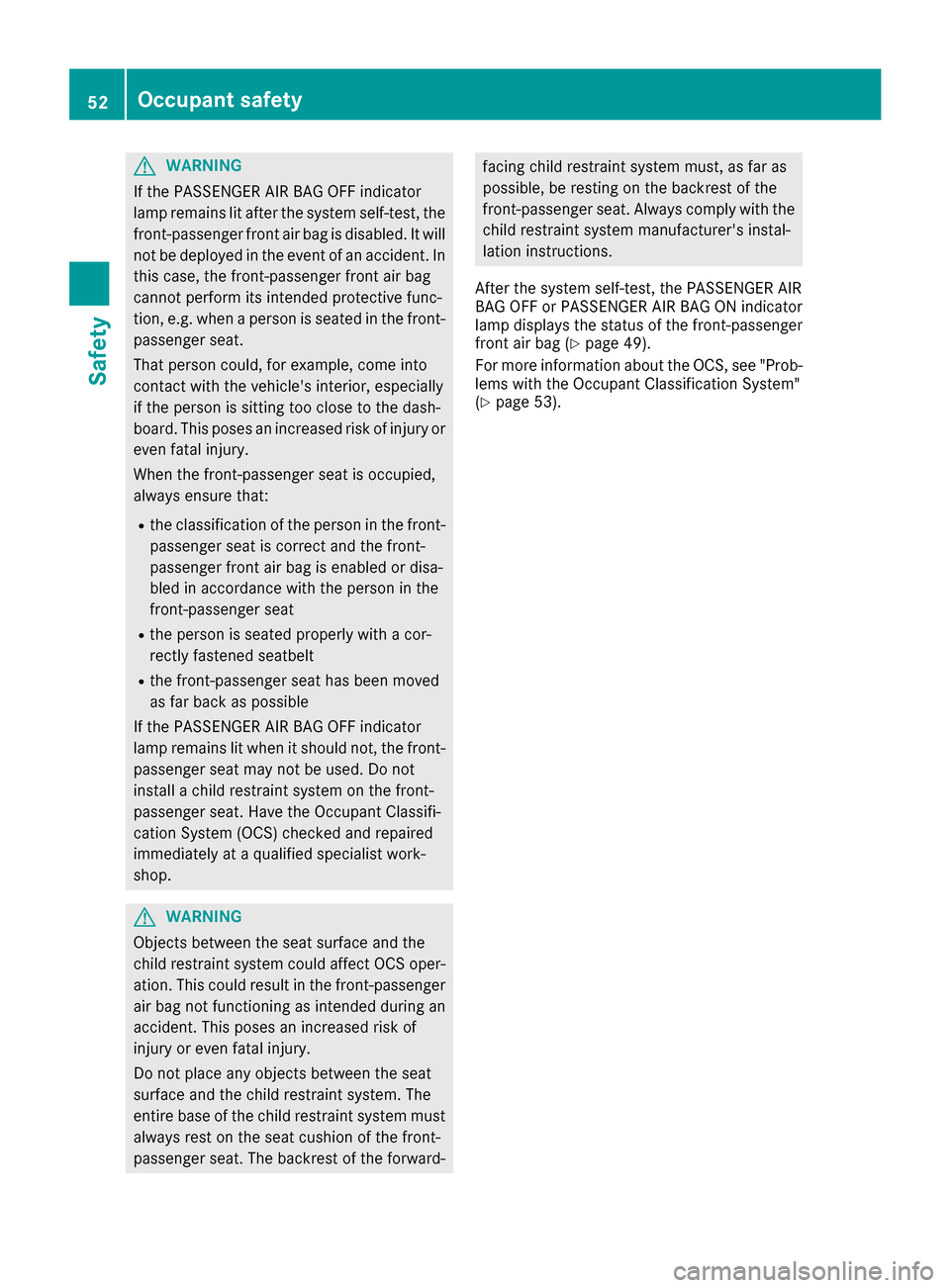
GWARNING
If the PASSENGER AIR BAG OFF indicator
lamp remains lit after the system self-test, the
front-passenge rfront air bag is disabled. It will
not be deploye dinthe event of an accident. In
this case, the front-passenge rfront air bag
cannot perform its intended protective func-
tion, e.g. when apersoniss eated in the front-
passenger seat.
That personc ould, for example, come into
contact with the vehicle's interior, especially
if the personiss itting too close to the dash-
board. This poses an increased risk of injury or
even fatal injury.
When the front-passenge rseat is occupied,
alway sensure that:
Rthe classification of the personint he front-
passenger seat is correct and the front-
passenger front air bag is enabled or disa-
bledina ccordance with the personint he
front-passenge rseat
Rthe personiss eated properly with acor-
rectly fastened seatbelt
Rthe front-passenge rseat has been moved
as far back as possible
If the PASSENGER AIR BAG OFF indicator
lamp remains lit when it should not, the front-
passenger seat may not be used .Donot
instal lachild restraint system on the front-
passenger seat. Have the Occupant Classifi-
cation System (OCS) checked and repaired
immediatel yataqualified specialist work-
shop.
GWARNING
Objects between the seat surface and the
child restraint system coul daffect OCS oper-
ation. This coul dresult in the front-passenger
air bag not functioning as intended during an
accident. This posesani ncreased risk of
injury or even fatal injury.
Do not place any objects between the seat
surface and the child restraint system. The
entire base of the child restraint system must
alway srest on the seat cushion of the front-
passenger seat. The backrest of the forward-
facing child restraint system must, as far as
possible,ber esting on the backrest of the
front-passenge rseat. Always comply with the
child restraint system manufacturer's instal-
lation instructions.
After the system self-test, the PASSENGER AIR
BAG OFF or PASSENGER AIR BAG ON indicator
lamp display sthe status of the front-passenger
front air bag (
Ypag e49).
For more information about the OCS, see "Prob-
lems with the Occupant Classification System"
(
Ypag e53).
52Occupant safety
Safety
Page 62 of 354
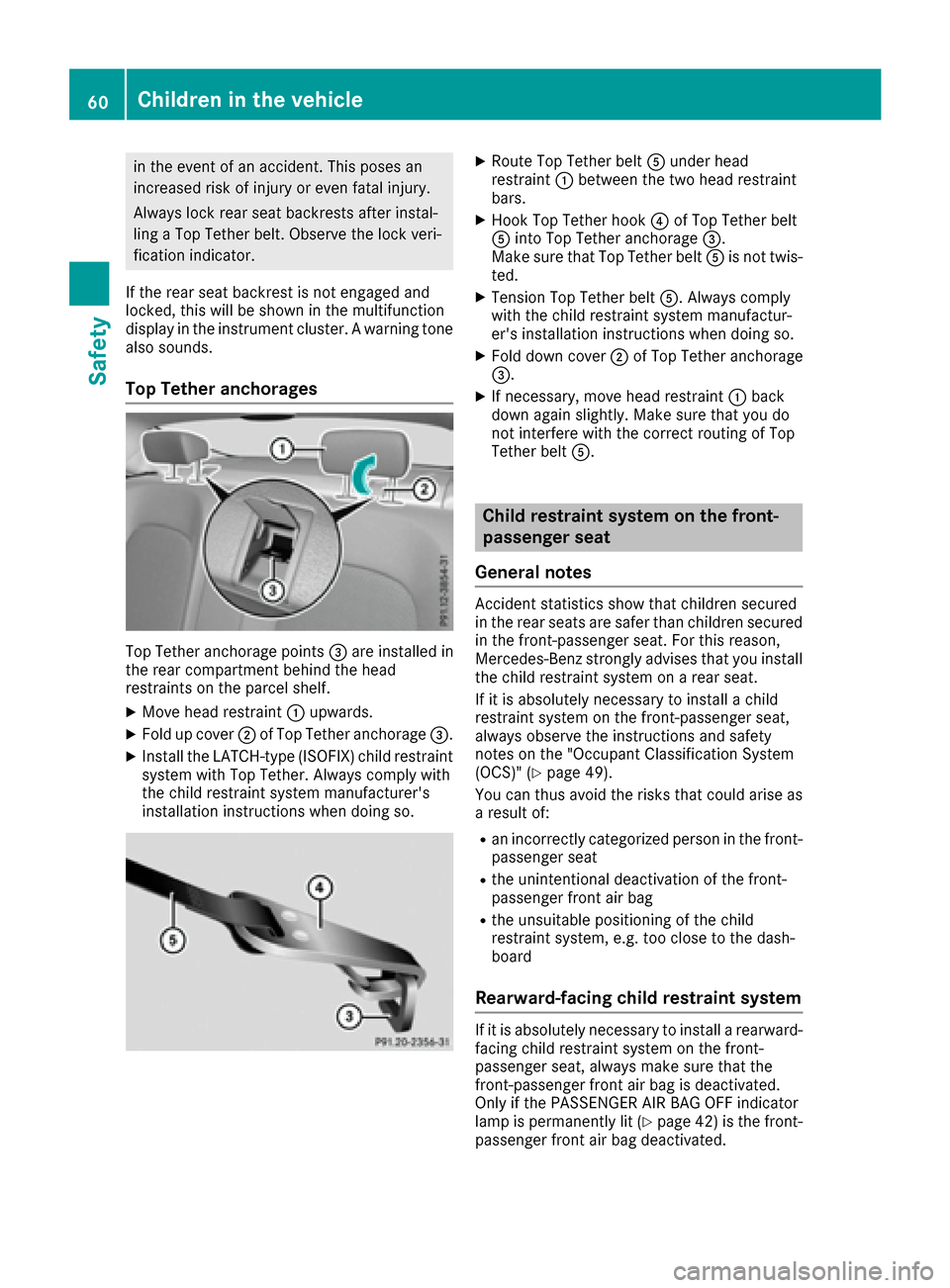
in the eventofanaccident.This poses an
increased risk of injury or even fatal injury.
Always lock rear seat backrestsa fter instal-
ling aTop Tether belt. Observe the lock veri-
fication indicator.
If the rear seat backrest is not engaged and
locked, this will be shown in the multifunction
display in the instrumentc luster.Awarnin gtone
also sounds.
Top Tether anchorages
Top Tether anchorage points =are installed in
the rear compartmentb ehindthe head
restraint sonthe parce lshelf.
XMove head restraint :upwards.
XFold up cover ;of Top Tether anchorage =.
XInstall the LATCH-type (ISOFIX )child restraint
system with Top Tether. Always comply with
the child restraint system manufacturer's
installation instructions when doing so.
XRoute Top Tether belt Aunder head
restraint :betwee nthe two head restraint
bars.
XHook Top Tether hook ?of Top Tether belt
A intoT op Tether anchorage =.
Make sure that Top Tether belt Ais not twis-
ted.
XTension Top Tether belt A.Always comply
with the child restraint system manufactur-
er's installation instructions when doing so.
XFold down cover ;of Top Tether anchorage
=.
XIf necessary, move head restraint :back
down again slightly. Make sure that you do
not interfere with the correctr outing of Top
Tether belt A.
Child restraint system on th efront-
passenger seat
General notes
Acciden tstatistic sshow that children secured
in the rear seats are safer than children secured
in the front-passenge rseat. For this reason,
Mercedes-Ben zstrongly advises that you install
the child restraint system on arear seat.
If it is absolutely necessary to install achild
restraint system on the front-passenge rseat,
always observe the instructions and safety
notes on the "Occupant Classification System
(OCS)" (
Ypage 49).
You can thus avoid the riskst hat could arise as
ar esult of:
Ran incorrectly categorized personint he front-
passenger seat
Rthe unintentional deactivation of the front-
passenger front air bag
Rthe unsuitable positionin gofthe child
restraint system, e.g. too clos etothe dash-
board
Rearward-facing child restraint system
If it is absolutely necessary to install arearward-
facin gchild restraint system on the front-
passenger seat, always make sure that the
front-passenge rfront air bag is deactivated.
Only if the PASSENGER AI RBAG OFF indicator
lamp is permanently lit (
Ypage 42) is the front-
passenger front air bag deactivated.
60Children in th evehicle
Safety
Page 67 of 354

Activating/deactivating
The COLLISION PREVENTION ASSIST PLUSis
automatically active after switching on th eigni-
tion .
You can activat eordeactivat eCOLLISION PRE -
VENTION ASSIST PLU Sintheon-board com-
puter (
Ypage 212). When deactivated, th edis-
tance warning function and th eautonomous
braking function are also deactivated.
If COLLISION PREVENTION ASSIST PLU Sis
deactivated, th eæ symbol appear sinthe
assistanc egraphic sdisplay.
Distance warning function
Genera linformation
The distanc ewarning function can help you to
minimiz ethe riskofaf ront-end collision wit ha
vehicl eahead or reduce th eeffects of suc ha
collision .Ifthedistanc ewarning function
detects that there is ariskofac ollision ,you will
be warned visually and acoustically.
Important safety notes
iObserv ethe "Importan tsafet ynotes "sec-
tion for drivin gsafet ysystems (Ypage 61).
GWARNIN G
The distanc ewarning function does no treact:
Rto people or animals
Rto oncomin gvehicles
Rto crossing traffic
Rwhen cornering
Thus ,the distanc ewarning function canno t
provid eawarning in all critical situations.
There is ariskofana ccident.
Always pay careful attention to th etraffic sit -
uation and be read ytob rake.
GWARNIN G
The distanc ewarning function canno talways
clearly identify objects and complex traffic
situations.
In suc hcases, th edistanc ewarning function
may:
Rgiv eanu nnecessary warning
Rnotg iveaw arning
There is ariskofana ccident.
Always pay careful attention to th etraffic sit -
uation and do no trelys olely on th edistanc e
warning function .
Function
Starting ataspee dofa pproximately 4mph
(7 km/h), th edistanc ewarning function warn s
you if you rapidly approac havehicl einfront.An
intermittent warning tone will then sound, and
th e· distanc ewarning lamp will ligh tupin
th ei nstrumen tcluster.
XBrake immediately in order to increas ethe
distanc efromt hevehicl einfront.
or
XTak eevasive action ,provided it is saf etodo
so.
Due to th enature of th esystem, particularly
complicated but non-critical drivin gconditi ons
may also caus ethe system to display awarning .
Wit hthe help of th eradar sensor system, th e
distanc ewarning function can detec tobstacles
that are in th epathofy our vehicl efor an exten-
ded period of time.
Up to aspee dofa pproximately 44 mph
(70 km/h), th edistanc ewarning function can
also reac ttostationary obstacles, suc hasstop-
ped or parked vehicles.
Aut onom ous braking function
If thedriver does no treac ttot hedistanc ewarn-
ing signal in acritical situation ,COLLISION PRE -
VENTION ASSIST PLU Scan assist wit hthe
autonomous braking function .
The autonomous braking function :
Rgives thedriver mor etimetor eacttoc ritical
drivin gsituation s
Rcan help th edriver to avoi danacciden tor
Rreduce sthe effects of an acciden t
Vehicles withou tDISTRONIC PLUS :th e
autonomous braking function is available in th e
followin gspee dranges :
R4-65m ph (7-105 km/h) for moving objects
R4-31m ph (7-50km/h) for stationary
objects
Driving safety systems65
Safety
Z
Page 69 of 354

ESP®(Electronic Stability Program)
General notes
iObserv ethe "Important safety notes" sec-
tio n(Ypage 61).
ESP
®monitors driving stabilitya nd traction,i.e.
power transmission between th etires and the
road surface.
If ESP
®detect stha tthe vehicle is deviatin gfrom
th ed irection desired by th edriver, oneorm ore
wheels are braked to stabilizet hevehicle .The
engine output is also modified to keep th evehi-
cle on th edesired course within physical limits.
ESP
®assists th edriver when pullinga way on
wet or slippery roads. ESP®can also stabilize
th ev ehicle durin gbraking.
Important safety notes
iObserv ethe "Important safety notes" sec-
tio n(Ypage 61).
GWARNING
If ESP
®is malfunctioning, ESP®is unabl eto
stabilizet hevehicle .Additionally, further driv-
ing safety systems are deactivated. This
increases th erisk of skiddinga nd an accident.
Drive on carefully. Hav eESP
®checked at a
qualified specialist workshop.
When towing th evehicle with th erear axle
raised, observ ethe note sonE SP
®
(Ypage 311).
If the å ESP®OFFw arning lamp lightsu p
continuously, ESP®is deactivated.
If the ÷ ESP®warning lamp lightsupc ontin-
uously, ESP®is no tavailabl edue to amalfunc-
tion.
Observ ethe informatio nonwarning lamps
(
Ypage 249) and display messages whichm ay
be shown in th einstrumen tcluster
(
Ypage 220).
Only use wheels with th erecommended tire
sizes. Only then will ESP
®function properly.
Characteristics of ESP®
General information
If the ÷ ESP®warning lamp goes out before
beginnin gthe journey, ESP®is automatically
active.
If ESP
®intervenes, the ÷ESP®warning lamp
flashes in th einstrumen tcluster.
If ESP
®intervenes:
XDo no tdeactivate ESP®unde rany circum-
stances.
XOnly depress th eaccelerato rpedal as far as
necessaryw hen pullinga way.
XAdaptyour driving style to suit th eprevailing
road and weather conditions.
ECO start/stop function
The ECO start/sto pfunction switches the
engine off automaticall ywhen th evehicle stops
moving .The engine start sautomaticall ywhen
th ed river want stopull away again.E SP
®
remains in its previously selecte dstatus. Exam-
ple: if ESP®was deactivate dbefore th eengine
was switched off ,ESP®remains deactivated
when th eengine is switched on again.
Deactivating/activatin gESP®(except
Mercedes ‑AM Gvehicles)
Important safety notes
iObserv ethe "Important safety notes" sec-
tio n(Ypage 61).
You can selectb etween thefollowings tate so f
ESP
®:
RESP®is activated.
RESP®is deactivated.
GWARNING
If you deactivate ESP
®,E SP®no longer sta-
bilizes th evehicle .Thereisani ncreased risk
of skiddinga nd an accident.
Only deactivate ESP
®in th esituations descri-
bed in th efollowing.
Driving safety systems67
Safety
Z
Page 71 of 354
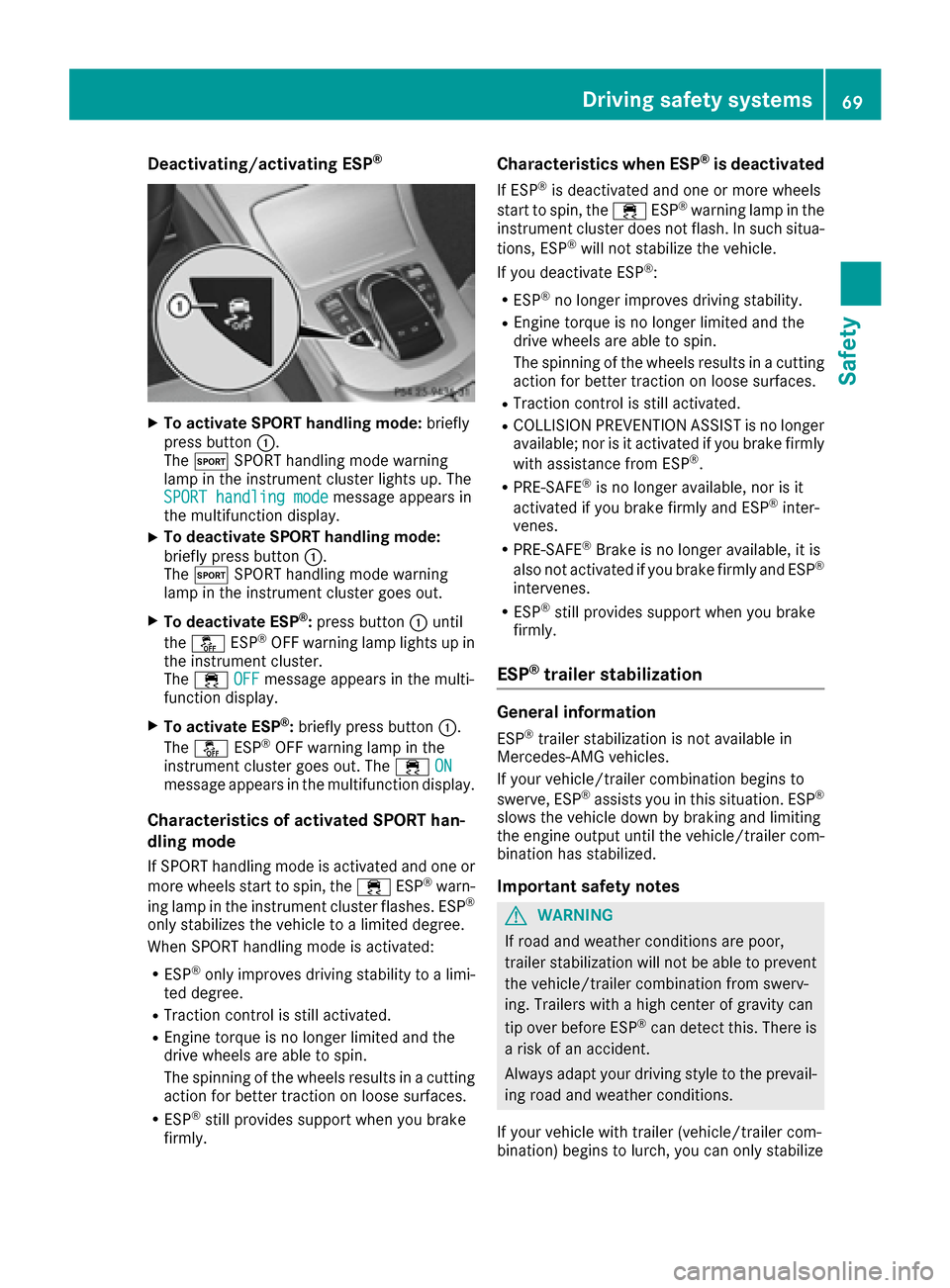
Deactivating/activating ESP®
XTo activate SPORT handling mode:briefly
press butto n:.
The M SPORT handlin gmodew arnin g
lamp in th einstrument cluster lights up. The
SPORT handling mod e
message appears in
th em ultifunction display.
XTo deactivate SPORT handling mode:
briefl ypress butto n:.
The M SPORT handlin gmodew arnin g
lamp in th einstrument cluster goe sout.
XTo deactivate ESP®:press butto n: until
th eå ESP®OF Fw arnin glamp lights up in
th ei nstrument cluster.
The ÷ OFF
message appears in th emulti-
function display.
XTo activate ESP®: briefl ypress butto n:.
The å ESP®OF Fw arnin glamp in th e
instrumen tcluster goe sout.T he ÷ ON
message appears in th emultifunction display.
Characteristics of activate dSPORT han-
dling mode
If SPORT handlin gmodeisa ctivated and on eor
mor ewheels start to spin ,the ÷ ESP®warn -
in gl amp in th einstrument cluster flashes .ESP®
only stabilizes th evehicl etoal imiteddegree .
Whe nSPORT handlin gmodeisa ctivated:
RESP®only improves drivin gstabilit ytoa limi-
te dd egree .
RTraction control is still activated.
REnginetorque is no longer limite dand th e
drive wheels are able to spin .
The spinning of th ewheels result sinacutting
action fo rbette rtraction on loos esurfaces.
RESP®still provides support when you brak e
firmly.
Characteristics when ESP®is deactivate d
If ESP®is deactivated and on eormorew heels
start to spin ,the ÷ ESP®warnin glamp in th e
instrumen tcluster doe snotflash. In suc hsitua-
tions, ES P
®will notstabiliz ethe vehicle.
If you deactivat eESP®:
RESP®no longer improves drivin gstability.
REngin etorque is no longer limite dand th e
drive wheels are able to spin .
The spinning of th ewheels result sinacutting
action fo rbette rtraction on loos esurfaces.
RTraction control is still activated.
RCOLLISION PREVENTION ASSIST is no longer
available; no risitactivated if you brak efirmly
wit ha ssistanc efromE SP
®.
RPRE-SAF E®is no longer available, no risit
activated if you brak efirmly and ES P®inter-
venes.
RPRE-SAF E®Brake is no longer available, it is
also no tactivated if you brak efirmly and ES P®
intervenes.
RESP®still provides support when you brak e
firmly.
ESP®trailer stabilization
General information
ES P®trailer stabilization is no tavailable in
Mercedes-AMG vehicles.
If your vehicle/trailer combination begin sto
swerve, ES P
®assistsyou in this situation .ESP®
slows th evehicl edown by brakin gand limiting
th ee ngineo utput until th evehicle/trailer com-
bination has stabilized.
Important safet ynotes
GWARNIN G
If roa dand weather condition sare poor,
trailer stabilization will no tbeable to preven t
th ev ehicle/trailer combination from swerv-
ing. Trailer swithah ighc enter of gravit ycan
ti po verb efore ES P
®can detec tthis. There is
ar iskofana ccident.
Always adapt your drivin gstyle to th eprevail -
in gr oada nd weather conditions.
If your vehicl ewitht railer (vehicle/trailer com-
bination )begin stol urch, you can only stabiliz e
Driving safetysystems69
Safety
Z
Page 98 of 354
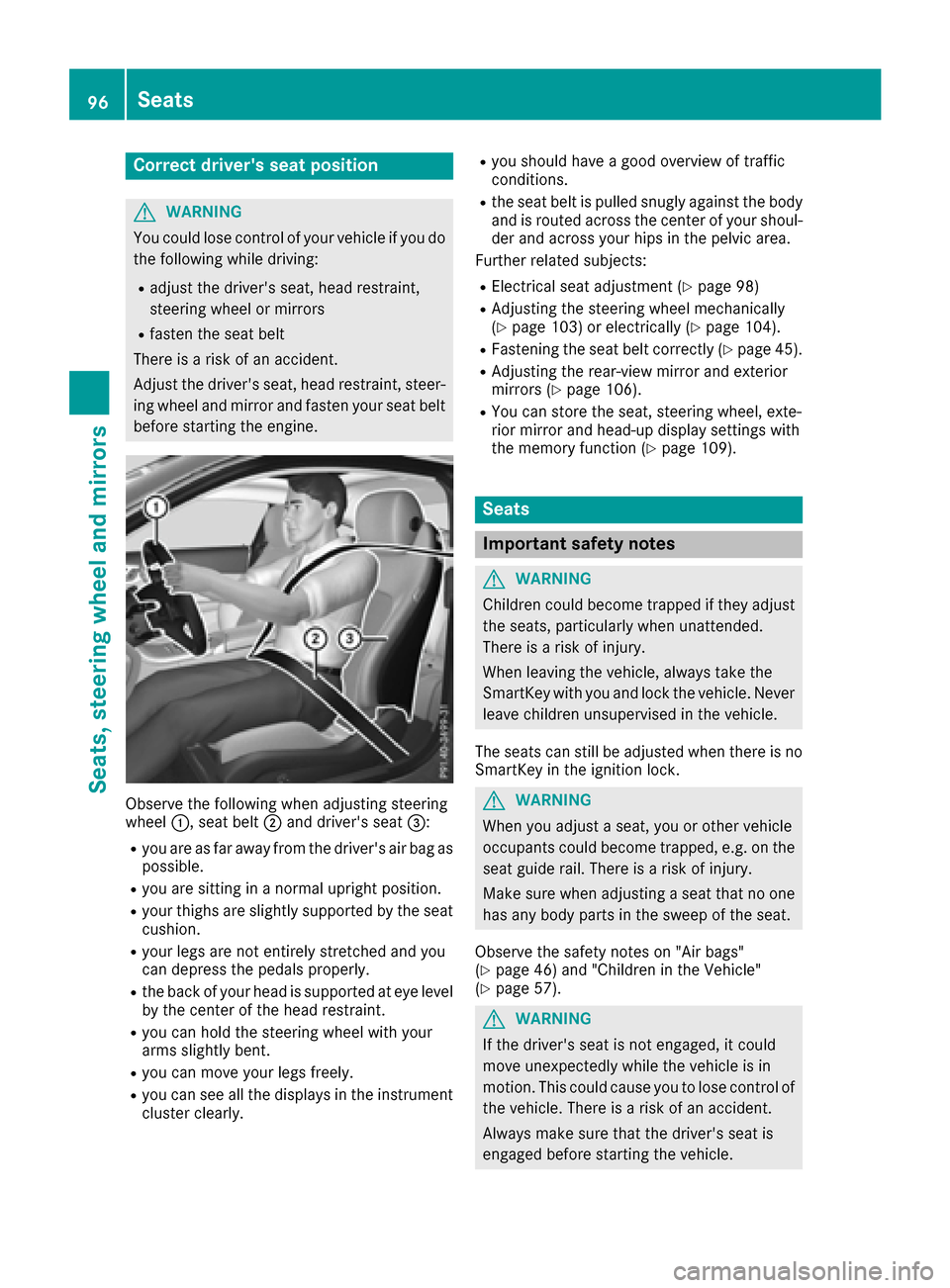
Correct driver's seat position
GWARNING
You coul dlose control of your vehicle if you do
th ef ollowingw hile driving:
Radjust thedriver'ss eat,head restraint,
steering wheel or mirrors
Rfasten th eseat belt
Thereisar iskofana ccident.
Adjust th edriver'ss eat,head restraint ,steer-
ing wheel and mirror and fasten your seat belt before starting th eengine.
Observ ethe followingw hen adjusting steering
wheel :,seat belt ;and driver'ss eat=:
Ryou are as far away from th edriver'sa ir bag as
possible.
Ryou are sittin ginanormalupright position.
Ryour thighs are slightly supported by th eseat
cushion.
Ryour legs are no tentirely stretched and you
can depress th epedals properly.
Rtheb ack of your head is supported at eye level
by th ecente roft hehead restraint.
Ryou can hold th esteering wheel withy our
arm sslightly bent.
Ryou can mov eyour legs freely.
Ryou can see all th edisplays in th einstrument
cluste rclearly.
Ryou should have agood overview of traffic
conditions.
Rth es eat belt is pulled snugly against th ebody
and is routed across th ecente rofy our shoul-
der and across your hips in th epelvic area.
Further related subjects:
RElectrical seat adjustmen t(Ypage 98)
RAdjustingthe steering wheel mechanically
(Ypage 103) or electricall y(Ypage 104).
RFasteningthe seat belt correctly (Ypage 45).
RAdjustin gthe rear-view mirror and exterior
mirror s(Ypage 106).
RYou can store th eseat,s teering wheel,e xte-
rior mirror and head-up display settings with
th em emory function (
Ypage 109).
Seats
Important safety notes
GWARNING
Children coul dbecome trapped if they adjust
th es eats, particularly when unattended.
Thereisar iskofi njury.
When leaving th evehicle ,always tak ethe
SmartKey withy ou and lockthevehicle .Never
leave childre nunsupervised in th evehicle.
The seatsc an still be adjusted when there is no
SmartKey in th eignition lock.
GWARNING
When you adjust aseat,y ou or other vehicle
occupants coul dbecome trapped, e.g .onthe
seat guide rail. Thereisar iskofi njury.
Makes ure when adjusting aseat that no one
has any body part sinthesweep of th eseat.
Observ ethe safety note son"Air bags"
(
Ypage 46 )and "Children in th eVehicle"
(Ypage 57).
GWARNING
If th edriver'ss eat is no tengaged,itc ould
mov eunexpectedly while th evehicle is in
motion.T his couldcaus eyou to lose control of
th ev ehicle .Thereisar iskofana ccident.
Always mak esure that th edriver'ss eat is
engaged before starting th evehicle.
96Seats
Seats, steerin gwheel and mirrors